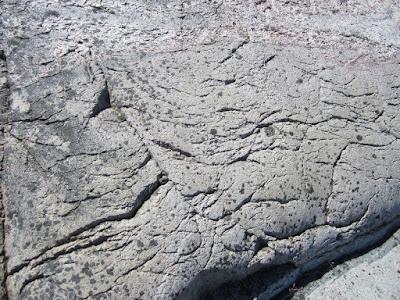Nowadays these features are grouped together and are called "chatter marks", but as we can see from the photos below, there is a lot of variety in the forms. The top photo shows a series of roughly parallel and regularly spaced linear fractures, approx perpendicular to the direction of ice movement:
The next one shows many fractures in a small area, some of them crescentic gouges and others irregular and linear. These were formed on a moulded surface across which the ice was rising so as to surmount a hill about 30m high. The theme of ice having its greatest effects on a rising land surface is a common one -- here there would have been compressive flow, as distinct from the extending flow accompanied by tension or dragging forces on the lee side of obstacles.
Below we see a very large crescentic gouge -- almost 1 m wide, with many more smaller chatter marks in the vicinity.
This rock face, again on a rising surface, has a high density of fractures of many different types.
And since large tools were required to create these gouges and fractures, here are a couple of photos of rocks seen littering the rock surface in the vicinity. These are quite large enough to have been effectively pressed into the rock surface by the pressure of overlying ice. The fractures are really brittle fractures -- and one contributing factor is the differential resistance of tool and bedrock. It helps, of course, if the tool is harder than the bedrock, but tools under compression are more resistant to breakage than rock surfaces under tension -- so even if the tool rock type is the same as that of the bedrock, erosion and fracturing becomes possible. But tools are of course also comminuted on the glacier bed. The problem with all of this is that the actual processes involved are almost impossible to observe under present-day ice sheets.






2 comments:
Is the rock in the first four photos volcanic? Looks like flow layers (don't know the correct term).
Does that influence the formation of crescentic gouges? Like the direction , depth and frequency?
Dave
Yes, I suspect that the details of those fractures etc are influenced by the foliations, banding and other structures in the bedrock. The rock is very complex, consisting of a wide variety of Pre-Cambrian basement rocks -- many of them volcanic or igneous and all metamorphosed over and again over a vast time span.
Post a Comment